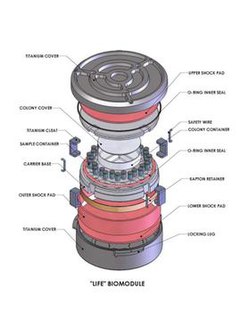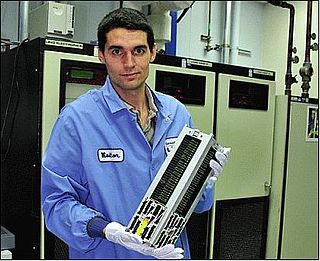
Nuclear pulse propulsion or external pulsed plasma propulsion is a hypothetical method of spacecraft propulsion that uses nuclear explosions for thrust. It originated as Project Orion with support from DARPA, after a suggestion by Stanislaw Ulam in 1947. Newer designs using inertial confinement fusion have been the baseline for most later designs, including Project Daedalus and Project Longshot.

Project Daedalus was a study conducted between 1973 and 1978 by the British Interplanetary Society to design a plausible uncrewed interstellar probe. Intended mainly as a scientific probe, the design criteria specified that the spacecraft had to use existing or near-future technology and had to be able to reach its destination within a human lifetime. Alan Bond led a team of scientists and engineers who proposed using a fusion rocket to reach Barnard's Star 5.9 light years away. The trip was estimated to take 50 years, but the design was required to be flexible enough that it could be sent to any other target star.

The British Interplanetary Society (BIS), founded in Liverpool in 1933 by Philip E. Cleator, is the oldest existing space advocacy organisation in the world. Its aim is exclusively to support and promote astronautics and space exploration.
Alan Bond is a British mechanical and aerospace engineer, who served as Managing Director of Reaction Engines Ltd and associated with Project Daedalus, Blue Streak missile, HOTOL, Reaction Engines Skylon and the Reaction Engines A2 hypersonic passenger aircraft.

The Journal of the British Interplanetary Society (JBIS) is a monthly peer-reviewed scientific journal that was established in 1934. The journal covers research on astronautics and space science and technology, including spacecraft design, nozzle theory, launch vehicle design, mission architecture, space stations, lunar exploration, spacecraft propulsion, robotic and manned exploration of the solar system, interstellar travel, interstellar communications, extraterrestrial intelligence, philosophy, and cosmology. It is published monthly by the British Interplanetary Society.

An interstellar probe is a space probe that has left—or is expected to leave—the Solar System and enter interstellar space, which is typically defined as the region beyond the heliopause. It also refers to probes capable of reaching other star systems.
David A. Hardy is a British space artist.
The Sir Arthur Clarke Award is a British award given annually since 2005 in recognition of notable contributions to space exploration, particularly British achievements. Nominations for the awards are made by members of the public, with shortlists drawn up by a panel of judges, who also choose the winner. Sir Arthur C. Clarke chose a special award independently of the public nominations.

Reaction Engines Limited is a British aerospace manufacturer based in Oxfordshire, England.

Duncan Alasdair Lunan, born October 1945, is a Scottish author with emphasis on astronomy, spaceflight and science fiction, undertaking a wide range of writing and speaking on those and other topics as a researcher, tutor, critic, editor, lecturer and broadcaster. He is known for his science writings as well as for his work on the Sighthill stone circle.
Advanced Space Propulsion Investigation Committee (ASPIC) was a research group of specialists, including Y.Minami, and T.Musha, which was organized under the Japan Society for Aeronautical and Space Sciences in 1994. The purpose of which was to study various non-chemical space propulsion systems instead of the conventional rocket for the use of space missions to the nearby Earth, the Moon, and the outer solar system, including plasma propulsion, laser propulsion, nuclear propulsion, solar sail and field propulsion systems which utilize a strain on space, zero-point energy in a vacuum, electro-gravitic effect, non-Newtonian gravitic effect predicted from the Einstein Theory of Gravity, and the terrestrial magnetism. The research report was published by the Japan Society for Aeronautical and Space Sciences in March 1996.

The Living Interplanetary Flight Experiment was an interplanetary mission developed by the Planetary Society. It consisted of sending selected microorganisms on a three-year interplanetary round-trip in a small capsule aboard the Russian Fobos-Grunt spacecraft in 2011, which was a failed sample-return mission to the Martian moon Phobos. The Fobos-Grunt mission failed to leave Earth orbit, and was destroyed.
Project Icarus is a theoretical engineering design study aimed at designing a credible, mainly nuclear fusion-based, unmanned interstellar space probe. Project Icarus was an initiative of members of the British Interplanetary Society (BIS) and the Tau Zero Foundation (TZF) started in 2009. The project was under the stewardship of Icarus Interstellar until 2019. It remains a BIS project.

KickSat was a satellite dispenser for small-satellite (femtosatellite) project inaugurated in early October 2011, to launch many very small satellites from a 3U CubeSat. The satellites have been characterized as being the size of a large postage stamp. and also as "cracker size". The mission launch was originally scheduled for late 2013 and was launched April 18, 2014.
Arthur Valentine Cleaver OBE FRAeS was a distinguished British rocket engineer. He co-authored a paper which discussed the possibilities and problems of nuclear rocket engines in 1948. After the Second World War he developed de Havilland's Sprite and Spectre rocket engines. He moved to Rolls Royce in 1957 and in 1960 he became general manager and chief engineer of the Rolls Royce's rocket departments, where he was responsible for the engines which powered the Blue Streak missile and Black Arrow launch vehicle. While the ELDO vehicle was ultimately unsuccessful and abandoned, the Blue Streak vehicle and its engines worked perfectly on every launch, and Cleaver was awarded the OBE for his part in developing them.
Robert Charles Parkinson MBE is a British aerospace engineer who worked on many projects including HOTOL which he cooriginated with Alan Bond.
Jane MacArthur FRAS is a British planetary scientist and science writer based in Leicester.
David Baker is a prolific British space author and self-described space scientist. His description of his career is that he first visited the US in 1962 and returned to work for NASA on the Gemini, Apollo and Space Shuttle programs between 1965 and 1984 as a Mission Planning and Analysis Department. He reports that he was present at NASA during Apollo 13 in 1970.








